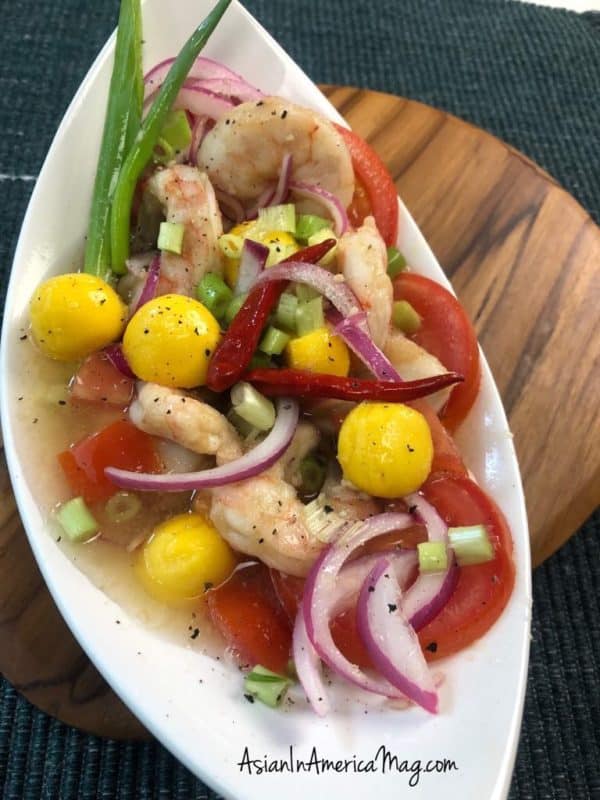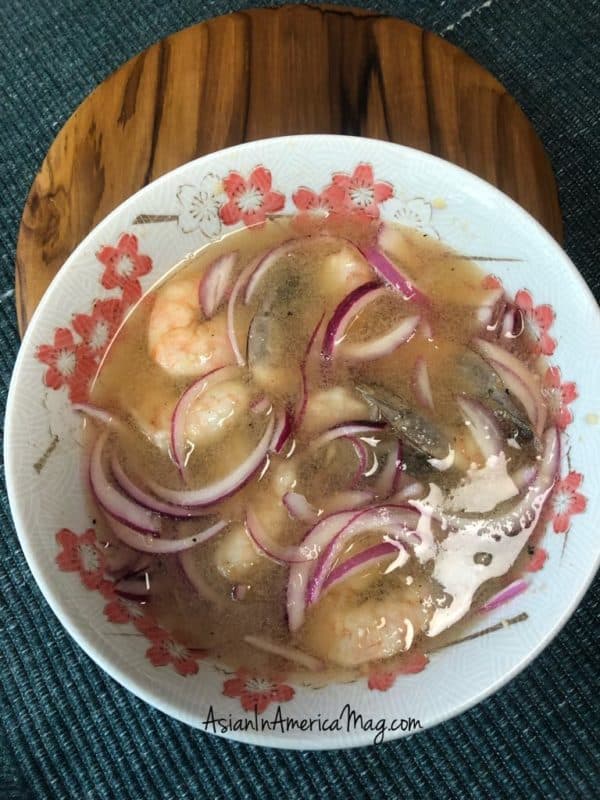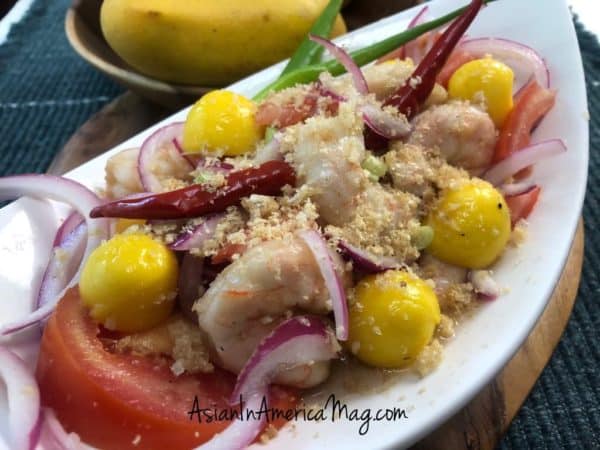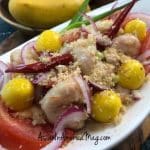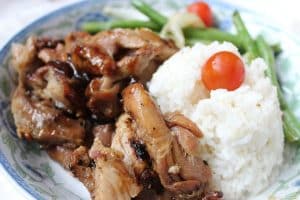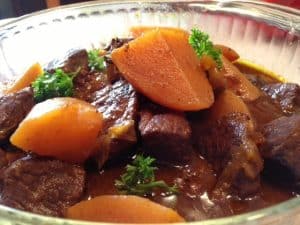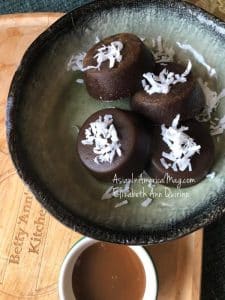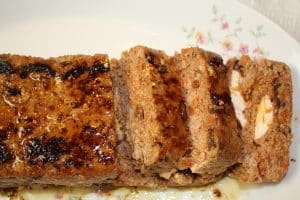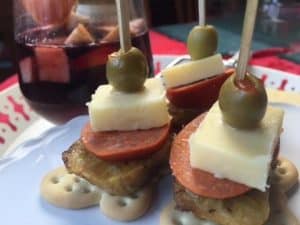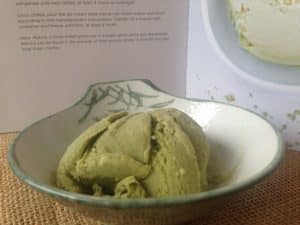Kinilaw of Shrimps with Mangoes and Tomatoes
As an Amazon Associate and member of other affiliate programs, I earn from qualifying purchases.
There was an abundance of mangoes and tomatoes in the markets so I made this Kinilaw of Shrimps with Mangoes, Tomatoes and Chicharron for an appetizer. Whenever we’d have family get-togethers in my childhood home in the Philippines my mother prepared kinilaw for appetizers and my father enjoyed it as pulutan with chilled beer. These days, when I go back to the Philippines for a balikbayan visit, my sister prepares kinilaw for us. She makes it with raw tanguigue and it’s superb. My version here was made with fresh shrimps and the tart, tangy flavors reminded me of meals back in my hometown, Tarlac.
The Filipino Kinilaw is similar to the Spanish ceviche or the Scandinavian gravlax. Different countries and cultures have their own recipes for fish or seafood cured in vinegar. In Filipino cooking, the first written version of kinilaw in Philippine culinary history was the account of Antonio Pigafetta, the Italian chronicler who recorded the voyages of Ferdinand Magellan, the explorer who discovered the Philippines*.
“Kinilaw may be one of the most ancient of Philippine foods and methods of preparation. Kinilaw and other indigenous cooking methods have survived many foreign influences brought about by colonization,” according to Filipino food anthropologist Doreen Gamboa Fernandez.
Today, in my American kitchen, on a warm summer day, preparing a bowl of shrimps for kinilaw was a relief. It’s practically a no-cook appetizer or side dish. As my mother and sister suggested, I always use fresh catch-of-the day shrimps, fish and seafood for kinilaw. I added sweet ripe mangoes, succulent vine-ripened Jersey tomatoes, white vinegar, red onions, fresh ginger, fiery chilies and topped it with crunchy chicharron bits. Often, the most scrumptious dishes are the easiest to prepare. Did I mention this was a dish that didn’t need cooking?
Kinilaw of Shrimps with Mangoes, Tomatoes and Chicharron
Ingredients
- 1/2 pound fresh large shrimps peeled, deveined, heads and tails removed
- 1 cup white vinegar
- 1/4 cup calamansi juice fresh or frozen concentrate (or use lemon juice)
- 1 whole red onion sliced or chopped
- 1 knob fresh ginger about 1-inch; peeled, sliced in julienne strips
- 1/2 cup ginger ale
- 1 teaspoon salt
- 1 teaspoon ground black pepper
- 1/2 cup chopped red or green bell pepper seeded
- 2 to 3 pieces siling labuyo (bird's eye chilies) sliced
- 2 whole tomatoes chopped
- 2 whole fresh, ripe mangoes sliced, pitted, shaped into round balls with a melon baller
- 1/2 cup crumbled chicharron for topping
- 2 stalks scallions chopped, for garnish
Instructions
- After peeling and removing heads and tails of shrimps, wash thoroughly. Drain any water.
- In a large, glass or non-reactive bowl, combine the following: the shrimps, white vinegar, calamansi juice, onions, ginger, ginger ale, salt , black pepper and red/green bell peppers. Stir in the chopped siling labuyo (bird's eye chilies). *Warning: Do not touch your face or eyes right after chopping the chilies. Wash hands thoroughly with soap and water after handling chilies.
- Stir and mix the shrimps, liquid and seasonings. Cover entire bowl with plastic wrap. Seal completely. Keep refrigerated for at least 4 hours or longer till shrimps turn to pink and look cooked.
- When ready to serve, mix in the mango balls and chopped tomatoes.Sprinkle the top with crumbled chicharron. Garnish with scallions. Serve chilled. Keep leftovers refrigerated at all times.
Nutrition
*Reference for Kinilaw history and origins were from the cookbook Kulinarya: A Guidebook to Philippine Cuisine (Anvil Publishing, Philippines).
Notes on Nutrition: The nutrition information provided is an estimate and will vary based on cooking methods and specific brands of ingredients used.
Did you like this recipe? I have more classic recipes inspired by my late mother’s cooking in my popular cookbook: My Mother’s Philippine Recipes. If you’re learning how to cook Filipino food or a fan of Philippine cuisine, buy my cookbooks and books on Amazon.com sold worldwide in paperback and Kindle format.
Hello, Friends! Please DO NOT LIFT OR PLAGIARIZE my original recipe, stories, photos or videos. All the images and content on this blog are COPYRIGHT PROTECTED and owned by my media company Besa-Quirino LLC. This means BY LAW you are NOT allowed to copy, scrape, lift, frame, plagiarize or use my photos, essays, stories and recipe content on your websites, books, films, television shows, videos, without my permission. If you wish to republish this recipe or content on media outlets mentioned above, please ASK MY PERMISSION, or re-write it in your own words and link back to my blog AsianInAmericaMag.com to give proper attribution. It is the legal thing to do. Thank you. Email me at [email protected]

